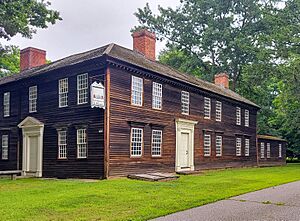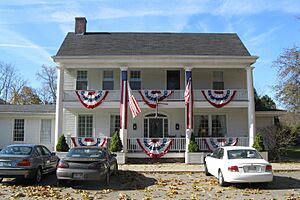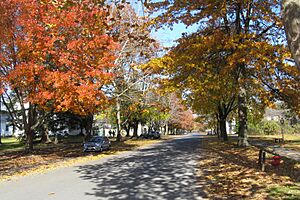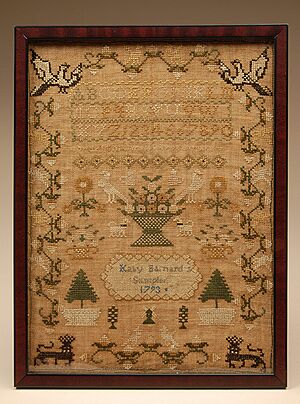Historic Deerfield facts for kids
|
Old Deerfield Historic District
|
|

Dwight House, Historic Deerfield
|
|
| Lua error in Module:Location_map at line 420: attempt to index field 'wikibase' (a nil value). | |
| Location | Deerfield, Massachusetts |
|---|---|
| Built | 1650 |
| Architect | Benjamin, Asher; et al. |
| Architectural style | Greek Revival, Federal |
| NRHP reference No. | 66000774 |
Quick facts for kids Significant dates |
|
| Added to NRHP | October 15, 1966 |
| Designated NHLD | October 9, 1960, see [1] |
Historic Deerfield is a special museum that helps us understand the past. It's all about the history and culture of Deerfield, Massachusetts. This village is in the beautiful Connecticut River Valley.
At Historic Deerfield, you can explore old houses and learn about life long ago. It helps visitors imagine what New England villages were like. The village of Old Deerfield is so important that it's a National Historic Landmark District. This means it's a place recognized for its special history.
Contents
Explore Historic Deerfield's Houses
Historic Deerfield has many amazing places to visit. There are eleven historic house museums to explore. Most of these houses offer guided tours. There's also a modern museum and a visitors center. You can find special exhibits, fun family activities, and workshops here. The Deerfield Inn is also available for visitors who want to stay overnight.
- Ashley House: This house was built in 1734. It belonged to Deerfield's minister in the 1700s. You can see furniture and dishes from that time.
- Allen House: Also built in 1734, this was the home of Henry and Helen Flynt. They were the people who started Historic Deerfield. They filled the house with their own collection of old American items.
- Stebbins House: Built in 1799, this brick house shows off the fancy style of the Federal period. Look for the French wallpaper panels. They show scenes from the voyages of Captain Cook! You can explore this house on your own.
- Barnard Tavern: This building was a busy tavern back in 1795.
- Dwight House: This house was built around 1754 in Springfield, Massachusetts. It was moved to Deerfield in 1950 to save it. Today, it's a museum where you can learn about old-time jobs and crafts.
- Frary House: Built around 1750, this house shows what it looked like in the 1890s. It was restored by Miss C. Alice Baker. You'll see old New England items and beautiful needlework.
- Hall Tavern Visitor Center: This building was first built around 1785 in Charlemont, Massachusetts. A ballroom was added later. It was moved to Deerfield and now serves as the main visitors center.
- Sheldon House: Built in 1754–55, this house shows what life was like between 1780 and 1810. You can take a self-guided tour here.
- Wells-Thorn House: This 1747 house has rooms that show different ways of living from 1725 to the 1850s.
- Williams House: Built around 1730, this house was updated in 1817. It features furniture and decorations in the Federal style.
- Flynt Center of Early New England Life: This is a modern museum. It has changing exhibits about history, old crafts, and beautiful art.
How Historic Deerfield Started
Historic Deerfield was created by Henry and Helen Flynt. They first visited Deerfield in 1936. Their son was attending Deerfield Academy at the time.
The museum was first called "The Heritage Foundation." After Henry Flynt passed away in 1970, its name was changed to Historic Deerfield.
Deerfield's Location and History
Historic Deerfield is located on a mile-long street. This street is over 330 years old! It runs along the Deerfield River in the Pioneer Valley of Western Massachusetts.
Long ago, before Europeans arrived, the Pocumtuck people lived here. The town of Deerfield was later created as a land grant. It was given to people from Dedham, Massachusetts.
For many years, Deerfield was a frontier village. This meant it was on the edge of settled areas. It faced challenges during different conflicts. In the 1670s, during King Philip's War, the village was briefly empty. Later, in the 1690s, it faced raids during King William's War.
A major event happened in 1704 during Queen Anne's War. The village was attacked in what is known as the Raid on Deerfield. Warriors from French and Native American groups entered the village. Many residents were taken captive. The village was also burned.
Most of the people who survived the attack and the journey to Canada eventually returned. However, one young girl, Eunice Williams, was adopted by a Mohawk family. She grew up with them and chose to stay. She visited her family in New England later in life.
Deerfield recovered from the raid. Over time, more settlers moved north and west. They created new towns in what are now Vermont and New Hampshire.
Art From Deerfield: White Dove Samplers
Deerfield is famous for a special type of needlework called "White Dove" samplers. These samplers were popular from 1790 to 1830. They all have a few things in common.
They are named for the white doves outlined in black that are sewn onto them. These samplers also usually show baskets of fruits and flowers. These designs are often arranged in a pyramid shape. They are usually placed below an alphabet or a short poem. A border on three sides often frames the whole picture.
Many of these samplers look very similar. This suggests that the girls who made them learned from the same teacher. We don't know who this teacher was or where they taught.
One famous example was made by Esther Slate in 1824 when she was ten years old. Her sampler has three alphabets in different styles. It also has a green vine border. Below the alphabets, Esther sewed a garden scene. It shows a blue house, trees, and a white picket fence. The two white doves stand with their wings spread.
The girls who made these samplers came from important families in the area. Many of these beautiful samplers are now part of the collection at Historic Deerfield. Katy Bernard made another example of this style in 1793.
Find More About the Collection
You can search for items from Historic Deerfield's collections online. A special database is kept by the Five College Museums/Historic Deerfield.
See also






